Exploring the Role of Corticosteroids in Managing Knee Osteoarthritis
Knee osteoarthritis (KOA) presents a pervasive challenge characterized by chronic pain and mobility limitations affecting millions worldwide. Among various treatments, intra-articular corticosteroid injections have gained traction for their ability to provide pain relief. This article delves into the scientific mechanisms behind corticosteroid effectiveness, examining clinical trial data, comparative therapies, and their role in provisional symptom management for knee osteoarthritis sufferers.
Understanding Knee Osteoarthritis and Its Impact
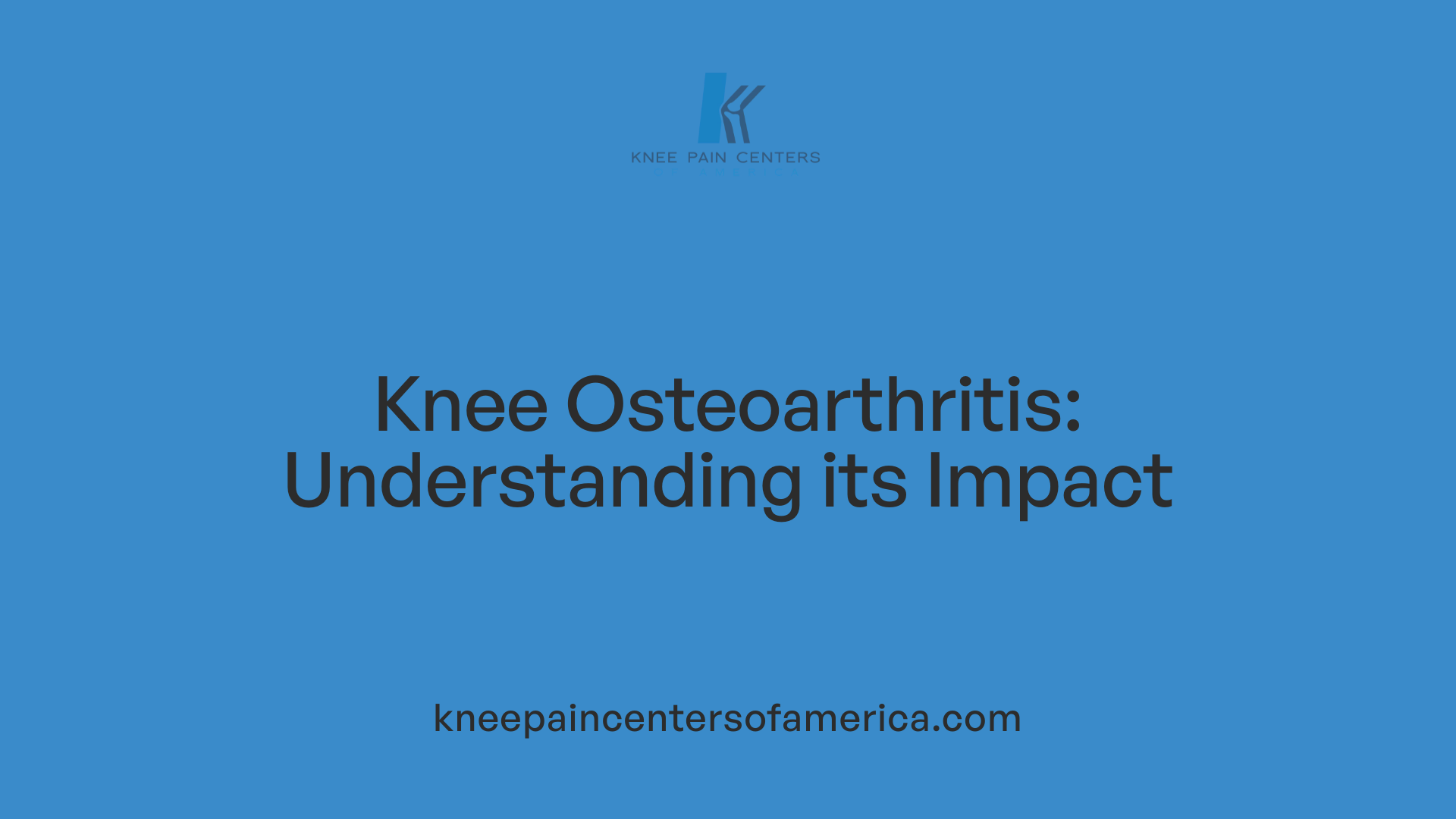
What is Knee Osteoarthritis and How Common Is It?
Knee osteoarthritis (KOA) is a common degenerative joint disease, especially prevalent among individuals aged 65 and older. It involves the gradual breakdown of joint cartilage and changes in the underlying bone, leading to joint damage.
What Symptoms Does Knee Osteoarthritis Cause?
People with KOA experience symptoms such as chronic joint pain, stiffness, and reduced mobility. These symptoms often worsen after activities and can lead to difficulty performing everyday movements.
How Does Knee Osteoarthritis Affect Quality of Life?
The persistent pain and stiffness from KOA significantly reduce quality of life. Affected individuals may face limitations in walking, climbing stairs, or engaging in physical activities, which can lead to discomfort, loss of independence, and emotional distress.
Mechanism of Action: How Corticosteroids Alleviate Joint Pain
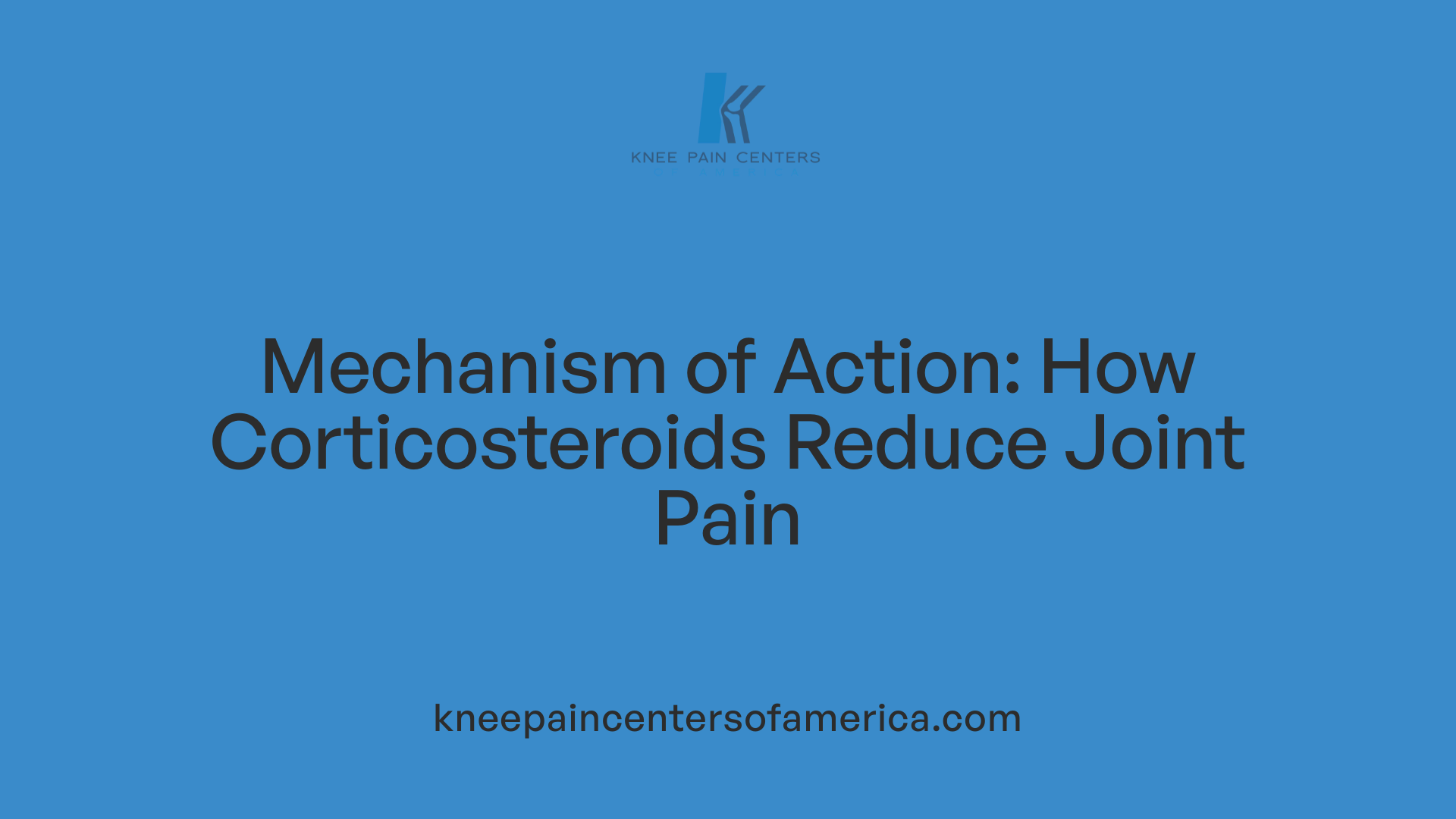
Interaction with Glucocorticoid Receptors
Corticosteroids exert their pain-relieving effects primarily through binding to glucocorticoid receptors located within joint tissues. This interaction initiates a cascade of intracellular events that modulate gene expression, resulting in decreased production of pro-inflammatory molecules.
Inhibition of Inflammatory Cytokines, Chemokines, and Adhesion Molecules
Once corticosteroids activate these receptors, they inhibit the synthesis and release of inflammatory cytokines and chemokines. These molecules typically promote inflammation by recruiting immune cells to the joint area. Corticosteroids also reduce expression of adhesion molecules, which decreases immune cell adherence and migration into inflamed joint tissue.
Reduction of Vasodilation, Vascular Permeability, and Inflammation
By blocking these inflammatory mediators, corticosteroids effectively reduce vasodilation—the widening of blood vessels—lessening erythema and swelling. They also decrease vascular permeability, limiting fluid leakage into joint spaces and reducing edema. This combined anti-inflammatory action leads to diminished pain and increased joint function in persons with knee osteoarthritis.
How Do Corticosteroids Relieve Pain in Knee Osteoarthritis?
Corticosteroids relieve pain by interacting with glucocorticoid receptors, which leads to inhibition of inflammatory cytokines, chemokines, and adhesion molecules. This inhibition reduces vasodilation, vascular permeability, and overall inflammation, ultimately alleviating joint pain and improving mobility.
This mechanism explains why corticosteroid injections offer moderate short-term relief, typically lasting several weeks, though their benefits tend to diminish beyond a month due to the transient nature of their anti-inflammatory effects.
Short-Term Pain Relief: Clinical Evidence for Corticosteroid Injections
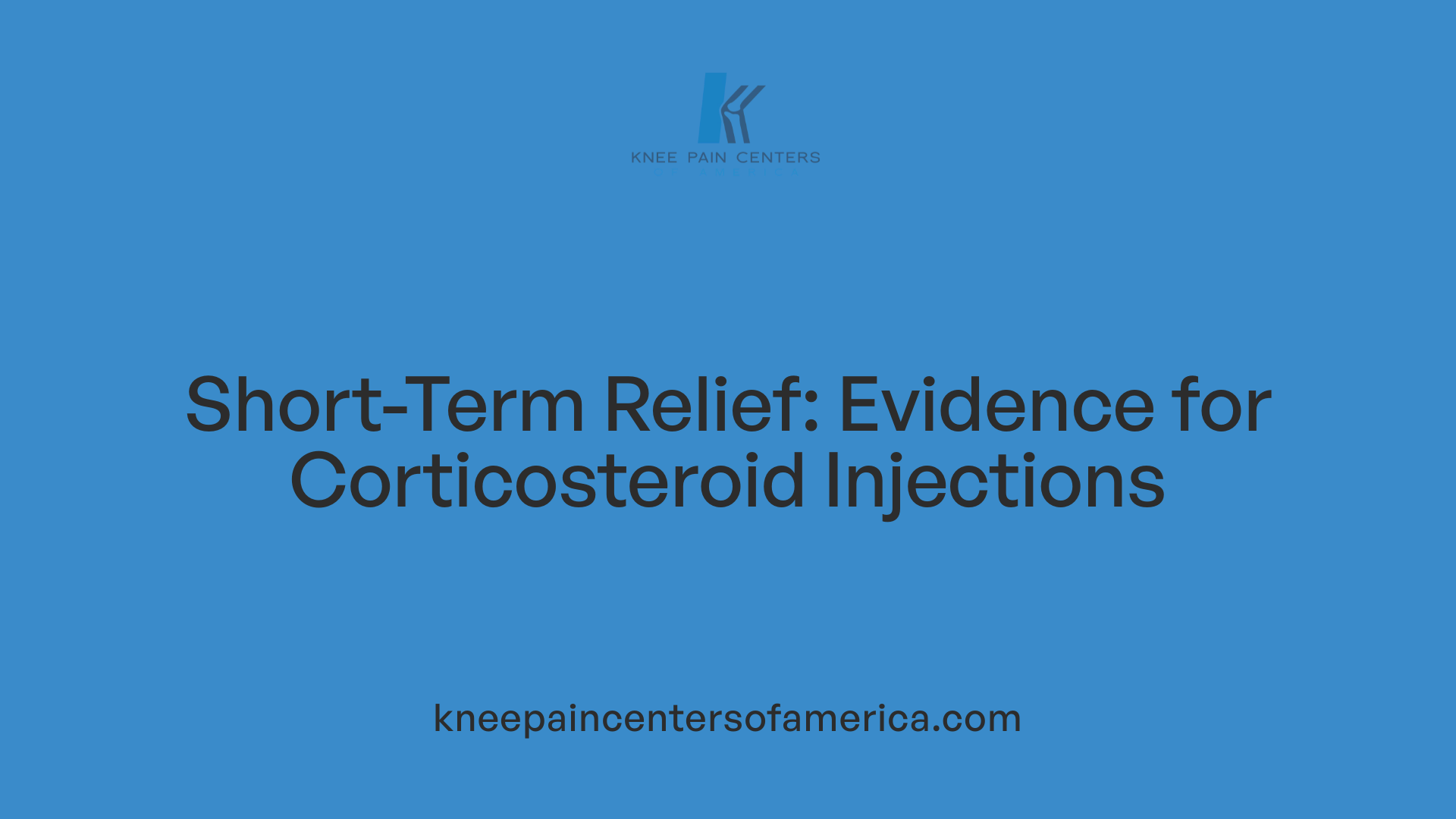
What is the typical duration of pain relief provided by corticosteroid injections?
Intra-articular corticosteroid injections (IACI) are a widely used treatment for knee osteoarthritis, primarily offering short-term pain relief. The analgesic effect usually lasts between several weeks and up to 3 to 6 months.
Duration of Analgesic Effect Typically 3–6 Months
Clinical studies suggest that corticosteroid injections can reduce knee osteoarthritis pain effectively for up to six months, although the most significant relief is often observed within the first few weeks after injection. The 2019 Osteoarthritis Research Society International (OARSI) guidelines conditionally recommend corticosteroid injections for knee OA, acknowledging their short-term benefit, while the American College of Rheumatology (ACR) strongly endorses their use but recommends limiting injections to no more than every three months.
Evidence from Randomized Controlled Trials
Randomized trials report that corticosteroid injections provide notable improvements in pain and function shortly after treatment. However, their benefits tend to diminish beyond a month, highlighting that corticosteroids mainly act on acute symptom relief. For example, a trial comparing glucocorticoid injections with physical therapy found that although corticosteroids offered rapid analgesia, physical therapy produced superior long-term functional outcomes at one year.
American College of Rheumatology Recommendations for Usage Frequency
The ACR advises caution in the frequency of corticosteroid injections due to potential adverse effects such as joint cartilage toxicity and risk of infection. The general recommendation limits injections to no more than every three months to minimize risks while maximizing pain control benefits.
Overall, corticosteroid injections serve as an effective option for short-term knee osteoarthritis pain management, providing crucial relief that may help patients delay more invasive procedures like knee replacement surgery.
Safety Profile and Potential Side Effects of Corticosteroid Injections
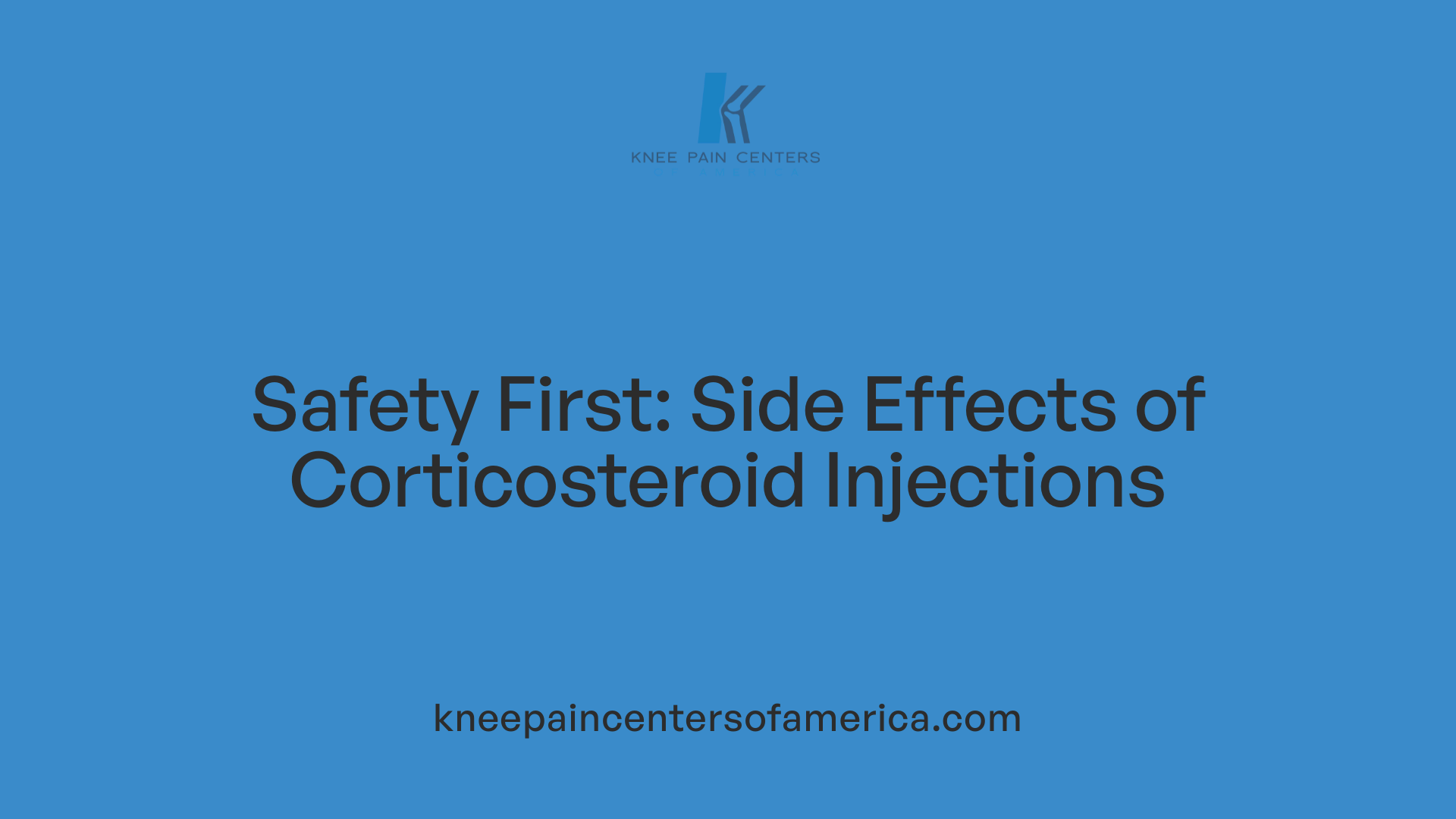
What are the main side effects and risks associated with corticosteroid injections?
Corticosteroid injections are widely used for short-term relief of knee osteoarthritis pain, but they come with several common side effects. Patients may experience an increase in blood glucose levels, which can be particularly concerning for individuals with diabetes. Skin changes such as hypopigmentation and subcutaneous fat atrophy around the injection site are also reported. Additionally, there is an elevated risk of infections due to the immunosuppressive nature of corticosteroids.
Risks of repeated corticosteroid injections
Repeated corticosteroid injections, especially more than two per year, carry increased risks. These include joint instability and tissue arthropathy, which can worsen joint function over time. Tendon rupture and avascular necrosis have been documented, particularly in weight-bearing joints like the hip. Such complications underscore the importance of limiting injection frequency and careful patient selection.
Incidence of serious adverse events
Although rare, serious adverse events such as septic arthritis have been associated with corticosteroid injections. The immunosuppressive effects of corticosteroids can facilitate joint infections if strict aseptic techniques are not maintained during administration. Patients and clinicians should be vigilant for signs of infection following the procedure.
Overall, while corticosteroid injections offer moderate short-term benefits in pain relief, their safety profile necessitates cautious use. Limiting the number of injections per year and monitoring for side effects can help mitigate potential harms. This safety consideration aligns with guidelines recommending no more than quarterly injections and careful patient assessment before repeated administration.
Comparative Effectiveness: Corticosteroids versus Physical Therapy

How does corticosteroid treatment compare with physical therapy for knee osteoarthritis?
A randomized trial conducted within the U.S. Military Health System compared intra-articular corticosteroid injections to physical therapy among 156 patients aged 38 or older with radiographic evidence of knee osteoarthritis. The primary measure of effectiveness was the Western Ontario and McMaster Universities Osteoarthritis Index (WOMAC) score assessed at one year, which evaluates pain, stiffness, and physical function.
Results demonstrated that patients receiving physical therapy experienced significantly better outcomes than those treated with corticosteroid injections. Specifically, the physical therapy group had a mean WOMAC score of 37.0, indicating less pain and better joint function, whereas the corticosteroid group scored a mean of 55.8. The difference of 18.8 points underscores a meaningful improvement favoring physical therapy.
Secondary functional outcomes also aligned with these findings. Patients in the physical therapy arm showed superior results on functional tests like the Timed Up and Go and the Alternate Step Test. Furthermore, on the Global Rating of Change scale, which captures patient perception of improvement, the median score was +5 ('quite a bit better') in the physical therapy group, contrasted with +4 ('moderately better') in the corticosteroid group.
In summary, this study highlights that while corticosteroid injections may offer short-term relief, physical therapy provides more durable benefits for pain reduction and functional enhancement in knee osteoarthritis over the long term, challenging the conventional preference for injections as the first-line treatment.
Impact of Corticosteroid Injections on Knee Replacement Rates
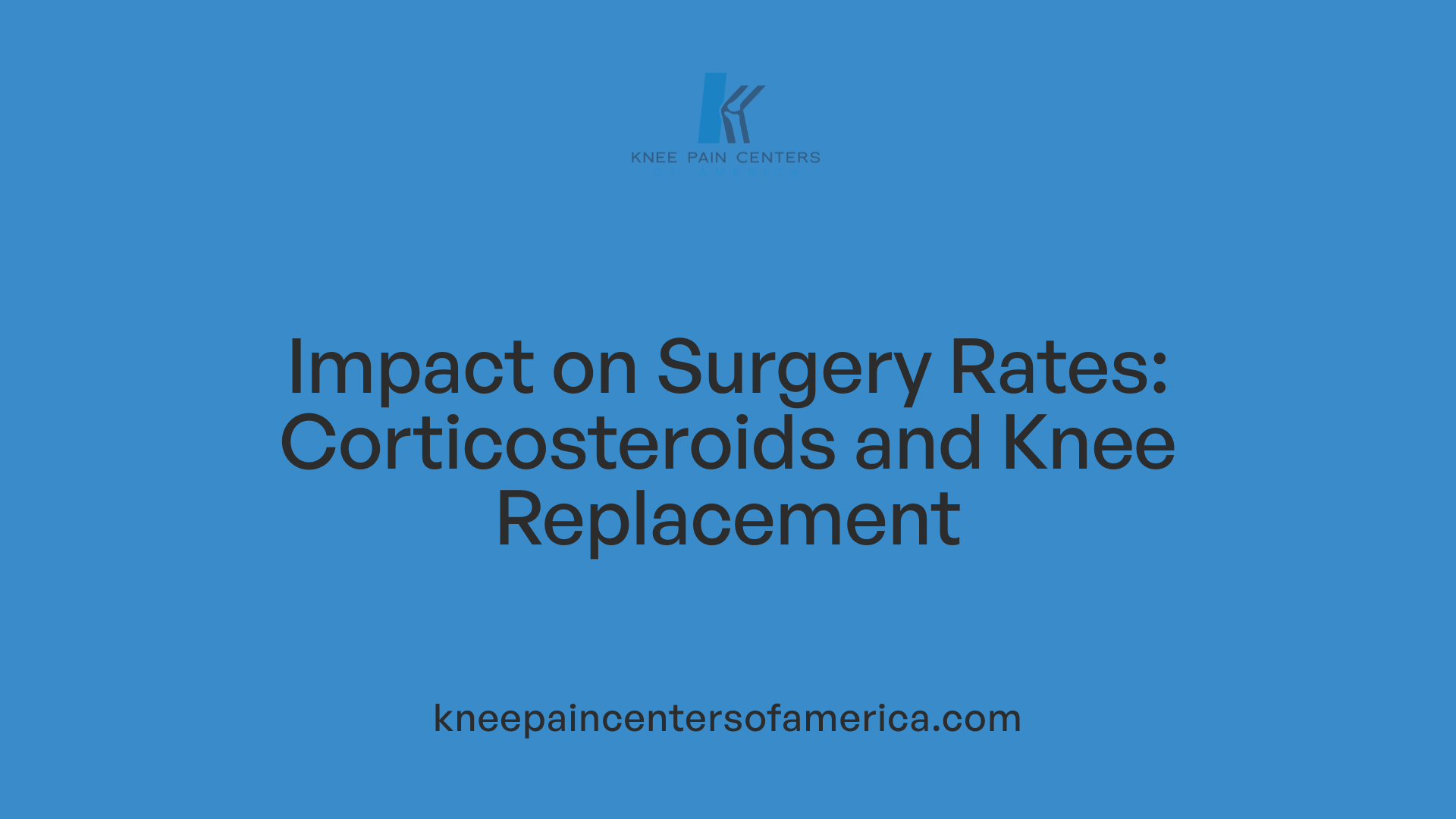
Observational Study Findings Suggesting Potential Delay in Knee Replacement Surgery
Intra-articular corticosteroid injections (IACI) are widely used for short-term pain relief in knee osteoarthritis. A notable observational study employing instrumental variable analysis indicated that patients who received IACI may experience a reduction in the rate of subsequent knee replacement surgeries over a follow-up period of five years. This suggests that the pain relief from corticosteroid injections could contribute to delaying the need for knee arthroplasty.
Contradictory Results from Propensity Score Analyses
While the instrumental variable study proposed a protective association, secondary analyses using propensity score methods did not confirm this benefit. Instead, these analyses suggested an increase in knee replacement rates at five years among patients treated with corticosteroids. The conflicting findings highlight the complexity of interpreting observational data due to potential residual confounding factors.
No Increased Risk of Adverse Postoperative Outcomes with Prior Corticosteroid Use
Importantly, the studies consistently report that prior use of corticosteroid injections before knee replacement surgery does not increase the risk of adverse postoperative outcomes. Patients who had received IACI were not observed to have higher rates of surgical complications or need for re-operations after knee arthroplasty.
Overall, intra-articular corticosteroid injections appear to offer short-term symptomatic relief and may have a role in temporarily reducing the urgency for knee replacement. However, evidence remains mixed regarding long-term effects on surgery rates. Importantly, corticosteroid use before surgery is not linked to worse postoperative safety profiles, supporting their continued use in managing knee osteoarthritis symptoms when appropriately indicated.
Regenerative Medicine Alternatives: PRP, Stem Cells, and Beyond

Comparison of corticosteroids with orthobiologic therapies like PRP and mesenchymal stem cells
Recent clinical trials have compared traditional corticosteroid injections with newer orthobiologic treatments—including platelet-rich plasma (PRP), autologous bone marrow aspirate concentrate, stromal vascular fraction, and allogeneic umbilical cord-derived mesenchymal stem cells—to evaluate their relative benefits in managing knee osteoarthritis.
Efficacy and safety outcomes at 12 months
A large study involving 480 patients assessed pain relief and functional outcomes at 12 months post-injection. The findings revealed no significant superiority of any biological treatment over corticosteroid injections based on visual analog scale pain scores and the Knee injury and Osteoarthritis Outcome Score (KOOS) pain score. MRI assessments also showed no notable changes in osteoarthritis progression across treatment groups.
Importantly, all treatments demonstrated good safety profiles with no procedure-related serious adverse events reported, underscoring the tolerated nature of both corticosteroid and biological injections.
Lack of superiority of biological treatments over corticosteroids in some trials
Although regenerative therapies like PRP are often considered promising due to their potential mechanisms—such as reducing inflammation and promoting cartilage repair—this evidence suggests that, at least over a one-year period, they do not provide additional pain relief benefits compared to corticosteroids in knee osteoarthritis patients.
Are newer regenerative treatments more effective than corticosteroid injections? Despite theoretical advantages, clinical trials indicate that PRP and stem cell therapies are not more effective than corticosteroid injections at 12 months for reducing pain and improving function in knee osteoarthritis, although safety is comparable. This highlights the need for further research to identify patient subgroups that might benefit more from these biologic options or to develop enhanced protocols that could augment their efficacy.
Platelet-Rich Plasma (PRP) and Hyaluronic Acid: Synergistic Effects for KOA

How do PRP and PRP plus hyaluronic acid compare to corticosteroids?
Platelet-rich plasma (PRP) and its combination with hyaluronic acid (HA) offer a promising approach for managing knee osteoarthritis (KOA) compared to traditional corticosteroid injections. PRP contains a rich concentration of growth factors that play a crucial role in relieving joint pain, reducing synovial hyperplasia, and promoting cartilage repair. This regenerative action goes beyond simple symptom management by potentially modifying disease progression.
Clinically, studies have demonstrated that both PRP alone and PRP combined with hyaluronic acid improve joint function and alleviate pain significantly more than corticosteroids over 3, 6, and 12 months. Patient-reported outcomes such as the WOMAC scores consistently favored PRP and the combination therapy, indicating sustained symptom relief and functional improvement. The addition of HA, a natural lubricant and shock absorber in synovial fluid, likely enhances these benefits by supporting cartilage regeneration and reducing joint erosion.
Regarding safety, PRP therapies and combined PRP + HA injections do not present increased adverse effects compared to corticosteroid or placebo treatments. This favorable safety profile, coupled with longer-lasting efficacy, makes them attractive options for patients seeking alternatives that avoid the potential cartilage toxicity and systemic side effects linked with corticosteroids.
In summary, PRP and PRP + HA therapies stand out for their ability to provide a more durable improvement in knee osteoarthritis symptoms while simultaneously fostering joint repair, positioning them as superior and safe alternatives to corticosteroid injections.
Hyaluronic Acid's Role and Controversies in Pain Management

What is the effectiveness of hyaluronic acid injections for knee osteoarthritis pain?
Hyaluronic acid (HA) is a natural component of synovial fluid, primarily functioning as a lubricant and shock absorber inside the knee joint. Its supplementation through intra-articular injections aims to reduce joint erosion and stimulate the body's own production of HA, potentially improving joint cushioning and mobility.
Clinical outcomes with HA injections show variability. While some patients experience significant pain relief and improved function lasting several months, others report minimal benefit. Compared to corticosteroids, which provide moderate but typically short-term pain relief lasting a few weeks, HA injections tend to offer longer-lasting therapeutic effects, often extending to several months post-injection.
Despite these benefits, the efficacy of HA remains controversial. Several studies report inconsistent results, and dosage regimens, formulations, and patient characteristics may influence outcomes. Furthermore, effects on disease progression are unclear, with MRI assessments generally showing minimal changes after HA treatment.
Comparison with corticosteroids in symptom relief
Corticosteroid injections are well-established for rapid onset anti-inflammatory effects, yielding short-term pain relief often within 1 to 3 weeks. However, their benefits tend to diminish quickly and repeated use carries risks such as cartilage damage and joint instability.
In contrast, HA injections generally act more slowly but provide sustained symptom improvement. Studies indicate hyaluronic acid can be effective in reducing pain at follow-ups ranging from two weeks to six months, whereas corticosteroids primarily offer acute relief.
In summary, HA injections serve as a joint lubricant and shock absorber supplement with variable but often longer-lasting efficacy than corticosteroids. The choice between HA and corticosteroids may depend on patient preference for speed versus duration of symptom relief and risk considerations.
| Treatment Type | Primary Function | Duration of Pain Relief | Safety Considerations |
|---|---|---|---|
| Hyaluronic Acid (HA) | Lubricant and shock absorber | Moderate to long-term (weeks to months) | Generally well tolerated; minimal serious adverse events |
| Corticosteroids | Anti-inflammatory via receptor binding | Short-term (1–3 weeks) | Potential cartilage toxicity with repeated injections |
This nuanced understanding supports shared decision-making tailored to individual patient needs and clinical contexts.
Guideline Recommendations for Intra-Articular Corticosteroid Use
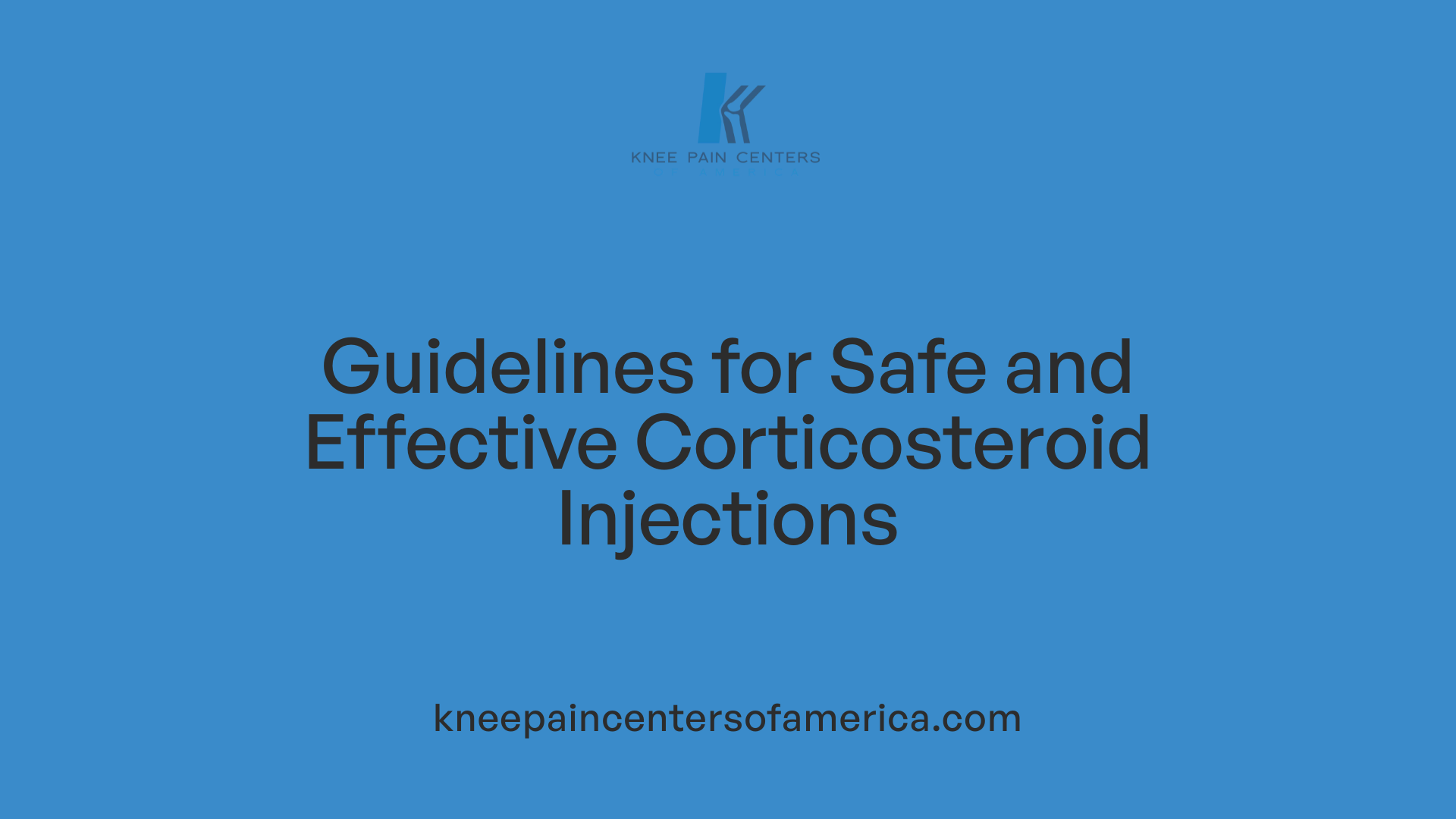
What do clinical guidelines state about corticosteroid injections for knee osteoarthritis?
Clinical guidelines provide nuanced guidance on the use of intra-articular corticosteroid injections (IACI) for knee osteoarthritis (OA). The American College of Rheumatology (ACR) strongly recommends corticosteroid injections for knee OA patients, emphasizing their role in providing symptomatic relief despite the typically short duration of benefit, generally lasting a few weeks. This recommendation highlights the value of IACI as a treatment option for acute pain management in knee OA.
On the other hand, organizations such as the Osteoarthritis Research Society International (OARSI) and the European League Against Rheumatism (EULAR) offer more conditional recommendations. These guidelines acknowledge the short-term efficacy of corticosteroids but caution about their potential adverse effects with repeated use. They suggest careful patient selection and emphasize limiting injection frequency to reduce risks associated with joint damage and other side effects.
Suggested injection frequency and clinical precautions
Consensus among guidelines generally advises administering corticosteroid injections no more than every three months, limiting to approximately two to four injections per year. This approach aims to balance symptom relief with minimizing potential complications such as cartilage toxicity, joint instability, or systemic side effects.
The ACR guidelines also recommend that corticosteroid injections be reserved for patients whose symptoms are not adequately managed by acetaminophen or other conservative measures. Clinicians are urged to monitor patients closely for side effects including increased blood glucose, skin hypopigmentation, fat atrophy, and possible infection risks.
In summary, while corticosteroid injections are embraced as a short-term therapy option within several guidelines, cautious use with appropriate intervals and patient monitoring is emphasized to optimize benefit and minimize harm in knee osteoarthritis management.
Epidemiological Methods Underpinning Corticosteroid Research

How do epidemiological methods affect research on corticosteroid injections?
Epidemiological methods play a crucial role in advancing our understanding of corticosteroid injections' effects in knee osteoarthritis treatment. Two prominent strategies used in recent research include instrumental variable analysis and propensity score matching.
Instrumental variable analysis helps control for unmeasured confounding factors that traditional observational studies may miss. By leveraging variables related to treatment choice but not directly related to outcomes, this method can provide more unbiased estimates. For example, a study using this technique suggested that intra-articular corticosteroid injections (IACI) may reduce rates of future knee replacement surgery over a five-year period.
In contrast, propensity score matching addresses measured confounders by balancing treatment and control groups based on known variables such as demographics and disease severity. However, when this method was used in secondary analyses, findings indicated an increased rate of knee replacement after corticosteroid treatment, highlighting how different approaches can yield contrasting results.
While both methods enhance research credibility, each has limitations. Instrumental variable analysis requires valid instruments that can be challenging to identify, and propensity score matching cannot adjust for unknown confounders. Furthermore, observational studies inherently carry risks such as selection bias and residual confounding, which can influence outcomes.
Nevertheless, combining these epidemiological tools strengthens studies by mitigating biases, ultimately improving the reliability of conclusions regarding corticosteroid injection benefits and risks. This nuanced understanding can help guide clinicians and patients in making informed treatment decisions.
Below is a summary of these epidemiological methods and their application in corticosteroid research:
| Method | Purpose | Strengths | Limitations |
|---|---|---|---|
| Instrumental Variable | Controls unmeasured confounding | Reduces bias from unknown factors | Requires a valid instrument; complex |
| Propensity Score Matching | Balances measured confounders | Easy to implement; balances observed variables | Cannot control unknown confounders |
| Observational Study | Examines real-world treatment outcomes | Reflects clinical practice; large sample sizes | Potential for bias; confounding effects |
Duration and Sustainability of Pain Relief from Corticosteroids
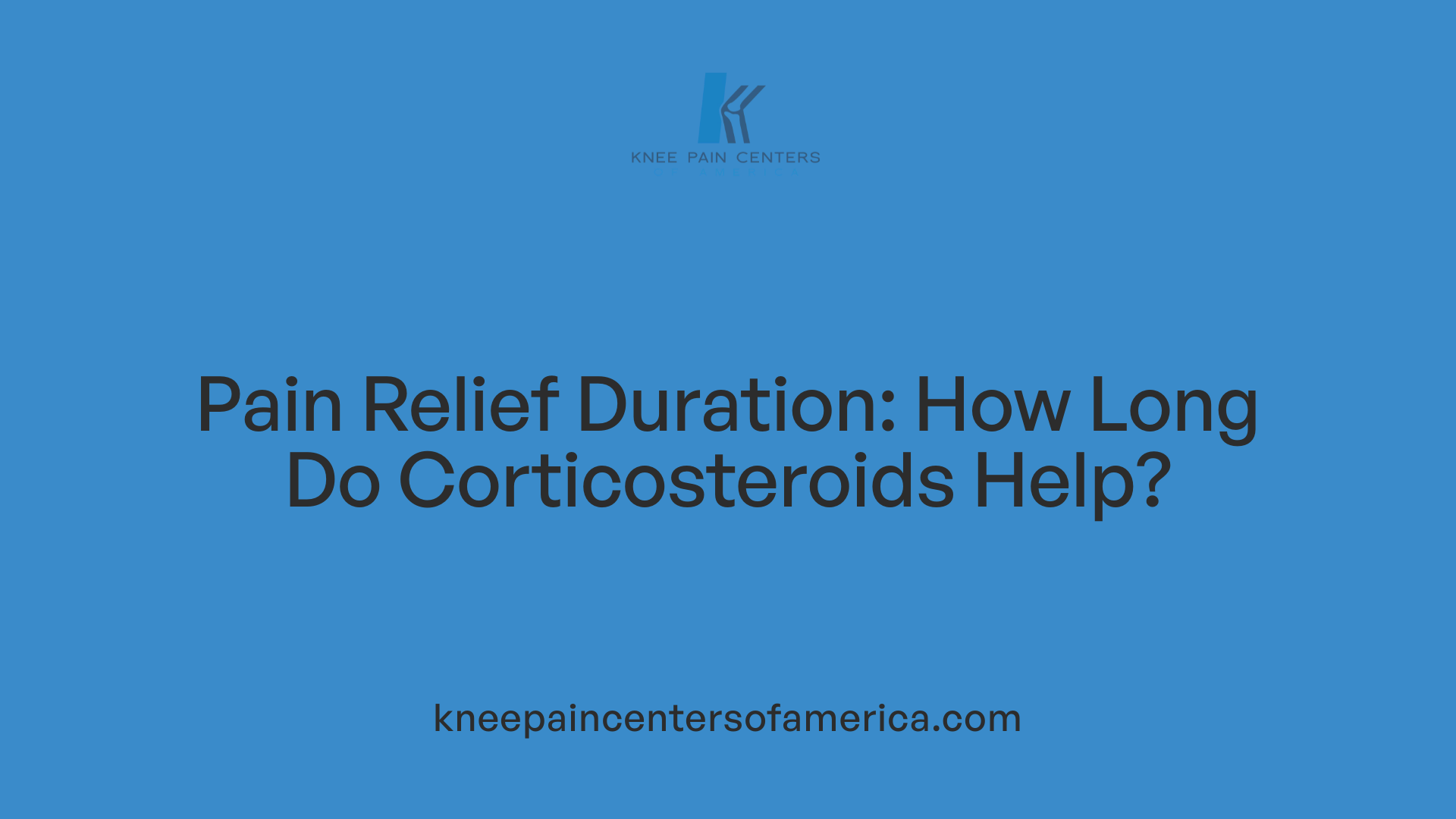
How sustainable is the pain relief from corticosteroid injections?
Intra-articular corticosteroid injections are a well-recognized treatment for knee osteoarthritis (OA), primarily offering short-term pain relief. Typically, patients experience a moderate reduction in pain symptoms that lasts for a few weeks, often peaking within the first 1 to 3 weeks after injection. However, the effectiveness tends to diminish considerably after around 3 to 4 weeks.
This transient benefit contrasts with other commonly used intra-articular treatments, such as platelet-rich plasma (PRP) and hyaluronic acid (HA). PRP has demonstrated pain relief that can persist from 6 up to 12 months, with improvements in joint function and pain sustained over that period. Similarly, HA injections are associated with longer-lasting therapeutic effects, with studies reporting significant pain reduction continuing for several months post-injection.
The differences in duration of symptom relief are linked to their mechanisms of action. Corticosteroids work by inhibiting inflammatory pathways, providing rapid but short-lived anti-inflammatory effects. Conversely, PRP and HA contribute not only to inflammation control but also promote cartilage repair, joint lubrication, and endogenous regeneration, which support more enduring symptom improvement.
While corticosteroid injections remain valuable for acute flare management and short-term relief, their diminishing effects highlight the importance of considering alternative or adjunct intra-articular therapies like PRP or HA for more sustained symptom control in knee osteoarthritis.
Clinical Trials and Randomized Controlled Studies on Corticosteroids

What do randomized controlled trials reveal about corticosteroid injection efficacy?
Randomized controlled trials (RCTs) consistently demonstrate that intra-articular corticosteroid injections offer significant short-term pain relief and functional improvement for patients with knee osteoarthritis. Measures such as the Western Ontario and McMaster Universities Osteoarthritis Index (WOMAC) score and visual analog scale (VAS) pain scores are frequently used to evaluate outcomes.
A notable trial comparing physical therapy with glucocorticoid injections reported that corticosteroids provided noticeable pain relief, but physical therapy yielded better WOMAC scores at one year, suggesting longer-lasting functional benefits for exercise-based interventions over steroid injections.
Another RCT involving orthobiologic treatments found corticosteroids safe and effective at 12 months, though no treatment surpassed corticosteroids in improving pain or function, highlighting the sustained yet moderate efficacy of corticosteroids.
Systematic reviews and meta-analyses reinforce that corticosteroid benefits are generally confined to a few weeks up to one month post-injection. This temporal limitation has led guidelines such as those from the American College of Rheumatology to recommend corticosteroids primarily for short-term symptomatic relief rather than long-term disease modification.
While corticosteroids exert their effect through anti-inflammatory mechanisms—suppressing cytokines and vascular inflammation—they do not contribute to long-term structural repair. This positions them as valuable for acute symptom management but less effective for sustained disease progression control.
The cumulative evidence from clinical trials has shaped current treatment standards, emphasizing cautious use of corticosteroids with intervals no shorter than three months and limiting frequency to prevent adverse effects, while advocating adjunct or alternative therapies for long-term osteoarthritis management.
Joint Integrity and Corticosteroid Use: Risks and Considerations

Does repeated corticosteroid use affect joint health adversely?
Repeated intra-articular corticosteroid injections, especially when administered more than twice a year, have been linked to adverse effects on joint integrity. Studies highlight increased risks including joint instability, tissue arthropathy, cartilage degradation, and tendon rupture. These adverse outcomes reflect the catabolic effects corticosteroids can exert on joint tissues beyond their anti-inflammatory benefits.
Potential for cartilage damage and joint degradation
Although corticosteroids effectively reduce inflammation and provide short-term pain relief, their usage carries concerns regarding long-term joint health. Evidence suggests corticosteroids may accelerate cartilage loss and contribute to joint degeneration, particularly with frequent or high-dose injections. The suppression of local immune response and collagen synthesis appears to compromise cartilage regeneration, raising the risk for progressive osteoarthritis.
Evidence linking repeated injections to tissue arthropathy and tendon rupture
Repeated corticosteroid exposure has been correlated with increased incidence of tissue arthropathy, characterized by deterioration of joint structures unrelated to primary disease progression. Importantly, tendons surrounding the joint are susceptible to weakening, leading to an elevated risk of tendon tears or rupture. This risk underscores the need for judicious injection intervals and dosing to avoid cumulative damage.
Balancing symptom relief with joint preservation
Clinicians face a challenging balance between managing acute osteoarthritis symptoms and preserving long-term joint integrity. While corticosteroid injections are recommended for short-term relief — typically lasting several weeks to a few months — guidelines caution against excessive frequency due to potential joint harm. The American College of Rheumatology advises limiting injections to no more than every three months, emphasizing a personalized approach. Alternative therapies such as physical therapy, platelet-rich plasma, or hyaluronic acid injections can offer symptom control with potentially lower risks for tissue damage.
| Aspect | Effect of Corticosteroids | Clinical Implication |
|---|---|---|
| Pain Relief Duration | Short-term (weeks to 3 months) | Useful for acute symptom management |
| Cartilage Integrity | Risk of accelerated degradation with repeated use | Limits frequency and cumulative dosage |
| Tendon Health | Increased risk of rupture with frequent exposure | Necessitates monitoring and conservative use |
| Injection Frequency | Recommended ≤ 2-4 injections/year | Minimize long-term joint damage |
This comprehensive understanding stresses cautious corticosteroid use, balancing effective symptom control with protection of joint structures in osteoarthritis management.
Comparative Cost Considerations of Corticosteroids and Other Treatments
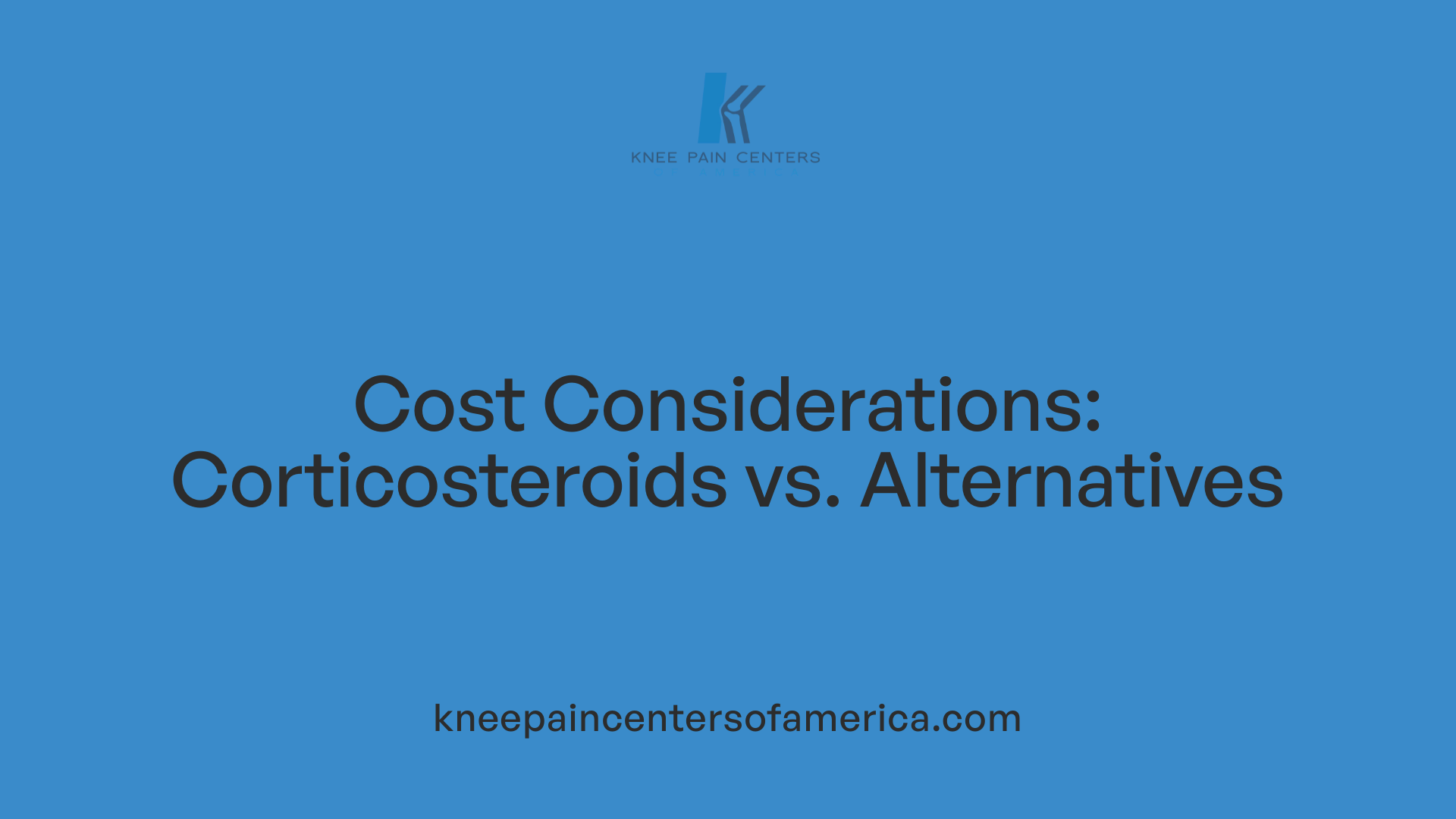
How do costs of corticosteroid injections compare to other treatments like physical therapy?
Healthcare costs over a one-year period appear to be similar between patients receiving intra-articular corticosteroid injections and those undergoing physical therapy for knee osteoarthritis. This finding is based on clinical trials that monitored treatment expenses without conducting formal cost-effectiveness analyses.
While corticosteroid injections offer short-term pain relief, physical therapy provides more sustained improvements in pain and function. Despite these clinical differences, overall economic expenditures related to each treatment pathway do not show significant divergence within a year of follow-up.
The lack of comprehensive economic evaluations means that decision-making must consider more than immediate costs. Clinicians and patients need to balance treatment efficacy, durability of benefit, patient preference, and potential side effects alongside financial factors.
Cost considerations also extend to indirect expenses such as time off work, need for additional treatments, and long-term health outcomes. The equivalency in healthcare spending between corticosteroids and physical therapy suggests that treatment decisions should prioritize clinical benefits and patient goals without concern for markedly differing financial burdens.
Future research including formal cost-effectiveness studies would better inform these decisions by quantifying value relative to cost. Until then, choosing between corticosteroid injections and physical therapy should be guided primarily by expected symptom relief duration, functional improvement, and safety profiles rather than cost differences alone.
Efficacy of Molecular Weight Variations in Corticosteroid Formulations

Use of Methylprednisolone and Triamcinolone
Methylprednisolone and triamcinolone are commonly utilized corticosteroids for intra-articular injections in knee osteoarthritis. Both have demonstrated comparable efficacy in terms of reducing pain and inflammation in the short term.
Influences of Formulation on Duration of Analgesia
Although their anti-inflammatory effectiveness is similar, the pharmacological properties of these corticosteroids affect how long pain relief lasts. Variations in molecular weight and formulation impact the drug's duration of action. For example, some preparations of triamcinolone may have extended residency in the joint, resulting in longer-lasting analgesia. This difference is particularly relevant because corticosteroid benefits typically last only a few weeks.
Clinical Relevance for Treatment Planning
Understanding these differences enables clinicians to tailor treatment plans based on patient needs. Selecting a corticosteroid formulation with a longer duration of effect may reduce the frequency of injections, potentially mitigating risks associated with repeated corticosteroid administration, such as joint instability or cartilage damage. Moreover, recognizing that efficacy is similar between agents helps direct focus toward optimizing dosing intervals and managing patient expectations for pain relief duration.
Do different corticosteroid formulations affect treatment outcomes?
Evidence indicates various corticosteroid formulations like methylprednisolone and triamcinolone yield similar pain relief efficacy. However, their pharmacokinetic differences influence how long patients experience analgesia. Consequently, these distinctions allow individualized treatment strategies to maximize therapeutic benefit while minimizing injection frequency and potential adverse effects.
Role of Intra-Articular Treatments in Disease Modification Potential

Pain control versus disease progression in KOA
Intra-articular treatments for knee osteoarthritis (KOA) mainly focus on alleviating pain and improving joint function. Corticosteroid injections provide short-term pain relief by reducing inflammation through their interaction with glucocorticoid receptors. However, this relief typically lasts only weeks, with no substantial evidence of slowing or reversing the disease's progression. Hyaluronic acid supplements the natural synovial fluid to lubricate and cushion the joint but has shown controversial efficacy in modifying disease outcomes.
Current evidence on regenerative therapies promoting joint remodeling
Regenerative medicine products, including platelet-rich plasma (PRP) and mesenchymal stem cells (MSCs), are proposed to go beyond symptom relief by potentially modifying the joint environment. PRP releases growth factors and anti-inflammatory molecules that can reduce synovial hyperplasia and promote cartilage repair. Clinical trials show that PRP and PRP combined with hyaluronic acid consistently outperform corticosteroids in pain reduction and functional improvement at 3, 6, and 12 months without additional safety risks. However, regenerative treatments have yet to demonstrate definitive reversal of osteoarthritis progression on imaging or histological levels.
Limitations of corticosteroids as primarily symptom-relieving agents
Despite their widespread use and recommendation by several guidelines, corticosteroids are largely limited to managing symptoms rather than modifying KOA's natural course. Repeated corticosteroid injections carry risks such as joint cartilage toxicity, increased infection risk, and potential joint degradation. Moreover, studies reveal no significant protective effect on disease progression, and some analyses even suggest an increased rate of knee replacement following corticosteroid use. Thus, corticosteroids remain a valuable option for short-term symptomatic relief but do not alter disease progression.
Can corticosteroids modify disease progression in knee osteoarthritis?
Currently, corticosteroids primarily provide symptom relief without modifying disease progression, whereas regenerative medicine products such as PRP and mesenchymal stem cells aim to promote joint remodeling and potentially alter progression.
Clinical Recommendations for Injection Frequency and Best Practices

What are the recommended limits on corticosteroid injection frequency?
Clinical guidelines generally recommend limiting intra-articular corticosteroid injections (IACI) to a maximum of two to four per year. These injections should be spaced at least three months apart to minimize potential risks such as joint cartilage toxicity, tissue arthropathy, and increased infection risk. The American College of Rheumatology advises no more than one corticosteroid injection every three months, reflecting a cautious approach to balancing short-term pain relief against possible long-term harm.
Timing to maximize benefit and minimize harm
The timing of corticosteroid injections is crucial to achieve effective symptom control while reducing side effects. Corticosteroids provide noticeable pain relief mainly within the first few weeks post-injection, typically lasting up to one month. To maximize benefits, injections should be administered during flare-ups or periods of significant pain and stiffness. Avoiding frequent repeated injections helps prevent complications such as joint instability or cartilage degeneration.
Patient-specific considerations
Decisions on injection frequency must consider individual patient factors including the severity of osteoarthritis, comorbidities like diabetes (which can be aggravated by corticosteroid-induced hyperglycemia), and previous response to injections. Patients with higher risk for adverse events may benefit from alternative therapies or extended intervals between injections. Shared decision-making is encouraged to tailor treatment plans based on patient goals and risk tolerance.
Overall, adherence to recommended injection frequencies and careful patient selection are essential to safely integrating corticosteroid injections into knee osteoarthritis management plans.
Patient Safety: Monitoring and Managing Injection-Related Risks

How can clinicians improve patient safety when administering corticosteroid injections?
Clinicians play a crucial role in ensuring patient safety during corticosteroid injections by implementing comprehensive screening and monitoring protocols. Prior to injection, evaluating patients for infection risk is essential to prevent septic arthritis, a rare but serious complication. Additionally, assessing glycemic control in diabetic patients is important, as corticosteroids can cause systemic hyperglycemia.
Screening for infection risk and glycemic control
Patients should be thoroughly evaluated for existing infections and immune status before receiving intra-articular corticosteroid injections. This precaution helps minimize risks of infection and systemic immune suppression. For diabetic patients, blood glucose monitoring before and after the injection can aid in managing potential transient hyperglycemia.
Strategies to mitigate skin and tissue damage
Precise injection techniques should be adopted to reduce risks such as skin hypopigmentation, subcutaneous fat atrophy, and joint cartilage toxicity. Avoiding repeated injections more than twice yearly is advised to minimize joint instability, tissue arthropathy, tendon rupture, and avascular necrosis, particularly in hip osteoarthritis cases.
Education about signs of complications
Educating patients about potential side effects and signs of complications is vital. Patients should be informed to report symptoms such as increased pain, swelling, redness, or fever promptly. Early detection and management of adverse events can prevent progression to severe outcomes.
By combining meticulous patient screening, refined administration techniques, and patient education, clinicians can optimize the safety of corticosteroid injections, ensuring effective pain relief while minimizing risks.
Balancing Efficacy and Risk: The Clinical Decision-Making Process

How do clinicians balance benefits and risks when recommending corticosteroid injections?
Clinicians must carefully weigh the moderate, short-term pain relief benefits of intra-articular corticosteroid injections (IACI) against their potential risks. While IACI can provide several weeks to a few months of effective analgesia in knee osteoarthritis, repeated use—particularly more than two injections per year—may lead to joint degradation, cartilage toxicity, increased susceptibility to infections, and other adverse effects such as tissue atrophy or systemic hyperglycemia.
Patient preferences play a significant role in decision-making. For example, some patients prioritize immediate pain relief to maintain daily function, even if benefits are transient. Others may be more concerned about long-term joint health and risk of complications. Comorbidities such as diabetes (due to corticosteroid-induced blood glucose increases) or immune suppression also influence suitability.
Weighing short-term benefits against long-term risks
Given the evidence, clinicians often recommend corticosteroids as a short-term intervention, typically limiting injections to no more than every 3 months to mitigate harms. Although corticosteroids can reduce inflammation by inhibiting cytokines and vascular permeability, the benefits generally last only a few weeks.
Newer therapies, including platelet-rich plasma (PRP) and hyaluronic acid (HA), offer longer-lasting pain relief and functional improvements without significant safety concerns, presenting alternatives or adjuncts to corticosteroid injections. Incorporating such options can delay or reduce the need for repeated corticosteroid use and potentially postpone knee replacement surgery.
Integration of patient preferences and comorbidities
The patient's overall health status, treatment goals, and tolerance for risk guide individualized care plans. For instance, patients with advanced osteoarthritis may prioritize delaying surgery and accept short-term corticosteroid treatments, while others may prefer longer-term solutions like physical therapy or regenerative medicine options.
Multimodal treatment approaches
Combining corticosteroid injections with physical therapy, lifestyle modifications, and potentially regenerative treatments supports a balanced strategy. Physical therapy has demonstrated superior outcomes in function and pain relief at 1 year compared to glucocorticoids alone, supporting its role in long-term management.
This multimodal approach aims to optimize symptom control while minimizing side effects, aligning with guideline recommendations that endorse cautious corticosteroid use integrated within comprehensive osteoarthritis management.
Future Directions: Improving Corticosteroid Use and Alternatives
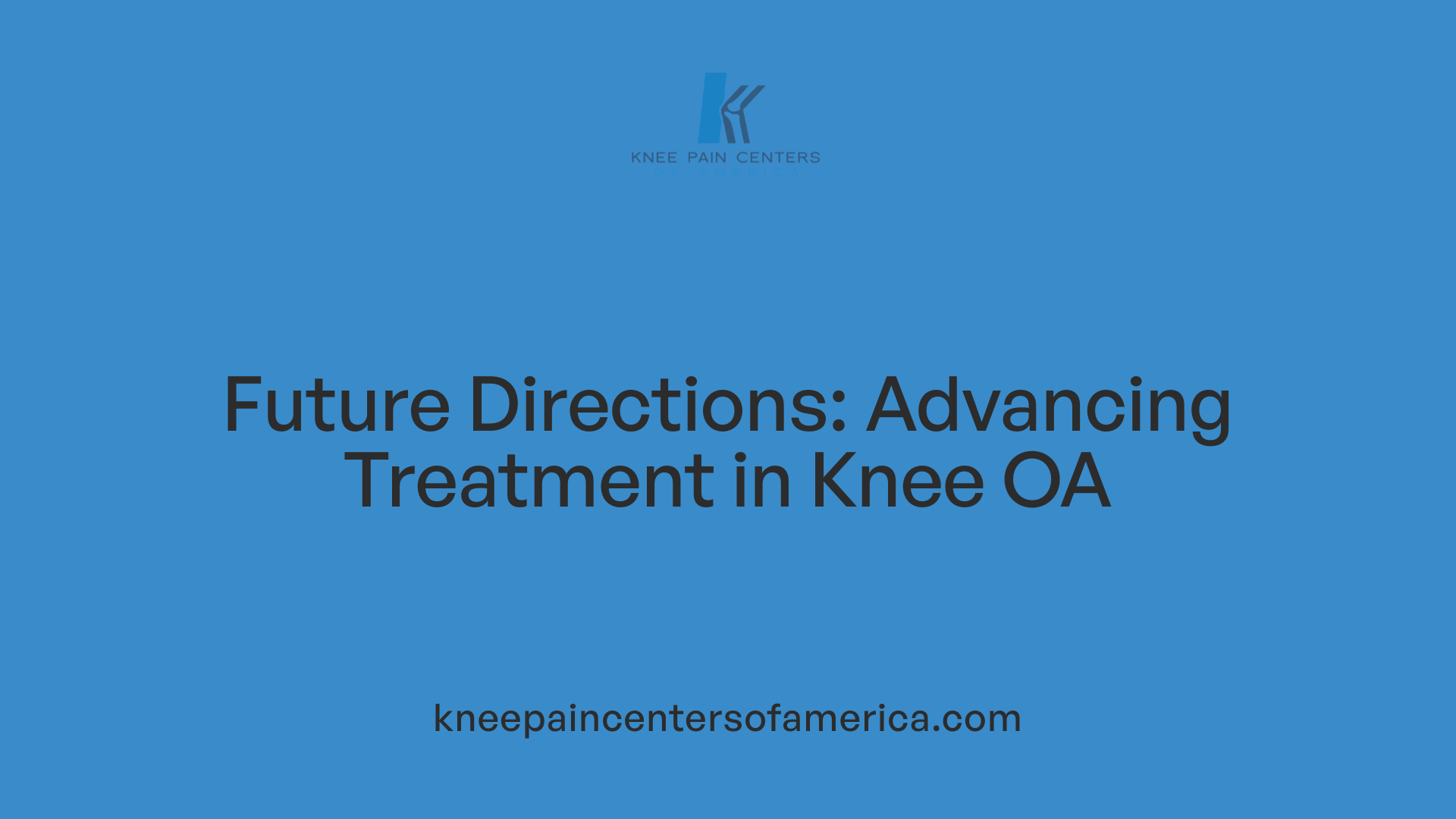
What are future prospects for corticosteroid treatment in knee osteoarthritis?
Future research is focused on refining corticosteroid formulations to enhance their duration while minimizing side effects. Current corticosteroid injections provide valuable short-term relief but are limited by their short efficacy window and potential risks such as joint degradation and increased infection rates with repeated use. Efforts to develop more sustained-release formulations could help extend analgesic effects beyond the typical few weeks.
Research into formulations with longer-lasting effects and fewer side effects
Scientists and clinicians are exploring modifications to corticosteroid delivery that may reduce systemic exposure and local tissue toxicity. Optimizing dosages and injection intervals aims to balance efficacy with safety, potentially allowing more flexible treatment schedules with reduced risk of complications like cartilage damage or tendon rupture.
Potential of combination therapies with PRP or hyaluronic acid
Combining corticosteroids with biologics such as platelet-rich plasma (PRP) and hyaluronic acid (HA) holds promise. PRP and HA have demonstrated benefits in improving joint function and pain relief, often sustaining effects longer than corticosteroids alone. Synergistic approaches may enhance cartilage repair, modulate inflammation more effectively, and prolong symptom improvement.
Emerging regenerative medicine strategies
Advances in regenerative medicine, including autologous cell injections like mesenchymal stem cells, are gaining attention as potential disease-modifying therapies. While current data suggest these therapies are safe, their superiority over corticosteroids is not yet established. Future studies are aimed at unlocking their full potential to remodel damaged joint tissues and possibly reverse osteoarthritis progression.
Overall, the future of corticosteroid use in knee osteoarthritis involves integrating improved pharmacologic formulations with biologic and regenerative techniques to provide durable pain relief, joint preservation, and enhanced quality of life for patients.
Navigating the Role of Corticosteroids in Knee Osteoarthritis Management
Corticosteroid injections remain a cornerstone for short-term pain relief in knee osteoarthritis, leveraging their potent anti-inflammatory actions to reduce swelling and discomfort. However, their benefits are typically transient, and repeated use carries risks that necessitate careful clinical judgment. Emerging regenerative treatments such as platelet-rich plasma and hyaluronic acid offer promising alternatives with more sustained symptom control and potential cartilage preservation, though corticosteroids remain valuable for acute symptom management. Optimal patient outcomes require balancing efficacy, safety, and individual preferences within a multimodal approach, underscoring the continuing evolution of KOA treatment guided by advancing scientific insights.
References
- Effect of intra-articular corticosteroid injections for knee ...
- Physical Therapy versus Glucocorticoid Injection for ...
- Cell-based versus corticosteroid injections for knee pain in ...
- Efficacy and safety of corticosteroids, hyaluronic acid, and ...
- Corticosteroids: Review of the History, the Effectiveness, ...
- Intra-articular Treatment of Knee Osteoarthritis - PubMed Central
- Injection-Based Management of Osteoarthritis of the Knee
- Effectiveness of intra-articular hyaluronic acid versus ...





